Echo- blinddog - User guide
Can my dog use Echo?
This section outlines the criteria that determine if a dog is suitable for using the Echo-blinddog system. For your dog to benefit from this echolocation device, it must meet the following conditions:
Significant Vision Loss:
Your dog must have substantial vision loss, making it reliant on alternative methods to navigate its environment.
Proper Hearing:
Your dog must have functional hearing to perceive the sound signals emitted by the Echo system.
Sufficient Concentration Ability:
Your dog must have a satisfactory ability to concentrate to effectively interpret and respond to the echolocation signals.
Good General Health:
Your dog must be in good health, without major health issues, ensuring the safe and optimal use of the system.
Appropriate Age:
Your dog should be within an appropriate age range, generally avoiding use on puppies due to their ongoing development of spatial learning. Older dogs should be individually assessed based on their health and adaptability.
This chapter provides detailed information on the essential criteria for determining a dog’s eligibility to use the Echo-blinddog system, ensuring a successful integration based on the specific needs of each canine user.
How to choose between Echo-Large and Echo-Small?
The choice between Echo-Large and Echo-Small primarily depends on the size of your dog. The operating principle remains the same, and the signals emitted by both Echo-Large and Echo-Small are identical.
The differences between the two devices include:
- Size: Small or large.
- Battery Life: Approximately 90-120 days for Echo-Large and 40-60 days for Echo-Small.
- Sound Emitters: Double sound emitters on Echo-Large and a single sound emitter on Echo-Small.
- Detection Angle: Wider on Echo-Large.
If your dog is medium-sized, we suggest opting for the large device. This choice will optimize battery recharges and take advantage of the double sound emitters, preventing your dog from disturbing the sound field when its nose is on the ground.
Precautions?
When using the Echolocation System for Blind Dogs, it is essential to take certain precautions to ensure the safety and well-being of your dog. Please follow these recommendations carefully:
Risk of Falls! Echo-BlindDog does not detect negative surfaces and objects such as holes.
Constant Supervision: Even with the echolocation system, it is crucial to closely monitor your dog during movement. The system provides support, but the owner’s vigilance remains indispensable to anticipate unforeseen situations.
Communication with Your Dog: Learn to interpret your dog’s signals when using the system. Observe its reactions and adapt your communication accordingly. Using Echo-BlindDog in complex or unfamiliar terrain requires great concentration from your dog. If the dog appears stressed or confused, be extra vigilant to anticipate dangers and reassure your dog.
Avoid Excessive Noise Distractions: In noisy environments, your dog may struggle to distinguish the system’s sound signals. Avoid areas with high noise levels whenever possible to optimize the system’s effectiveness.
Warning: While the echolocation system is a valuable tool, it does not replace the owner’s responsibility. Be mindful of the environment, adapt your behavior based on the dog’s reactions, and don’t hesitate to intervene manually if unforeseen situations arise. In case of doubt, it is always better to prioritize the dog’s safety by intervening directly.
Getting Started with Your Echo-BlindDog Upon Receipt
I just received the Echo device for my dog.
Unbox the device.
Apply the “reference phone” method. (See FAQ: “Sound Emission Verification and the ‘Reference Phone’ Method”)
Attach Echo to the dog’s collar by threading the collar through the straps and the stabilizer.
The diagram above illustrates the correct placement of the Echo device on your dog’s collar, highlighting incorrect positions (in red) and the correct position (in green).
Too High Position (Red): Placing the Echo too close to the dog’s neck or head can interfere with the propagation of acoustic waves, making the device less effective.
Correct Position (Green): The Echo device should be installed at shoulder height (point A) on the dog. This area is ideal for ensuring optimal acoustic wave propagation and proper device functionality.
Too Low Position (Red): If the Echo is placed too low on the chest or near the abdomen, it may be obstructed by the dog’s movements, reducing its effectiveness.
Make sure the device does not dip into the water bowl when the dog drinks.
Press the operating mode selection button to take the device out of pause mode.
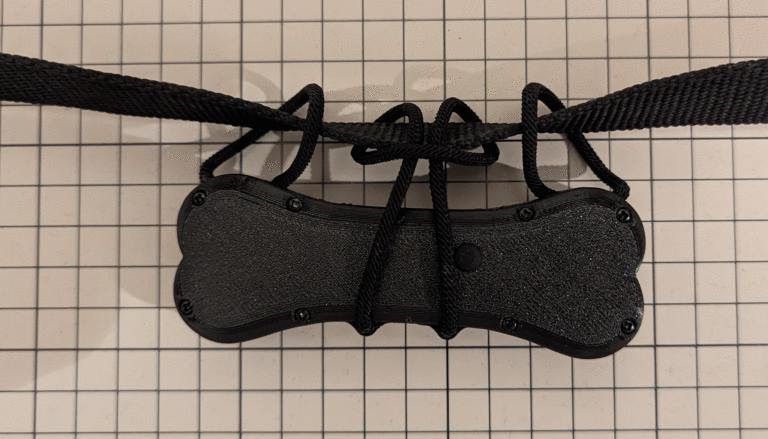
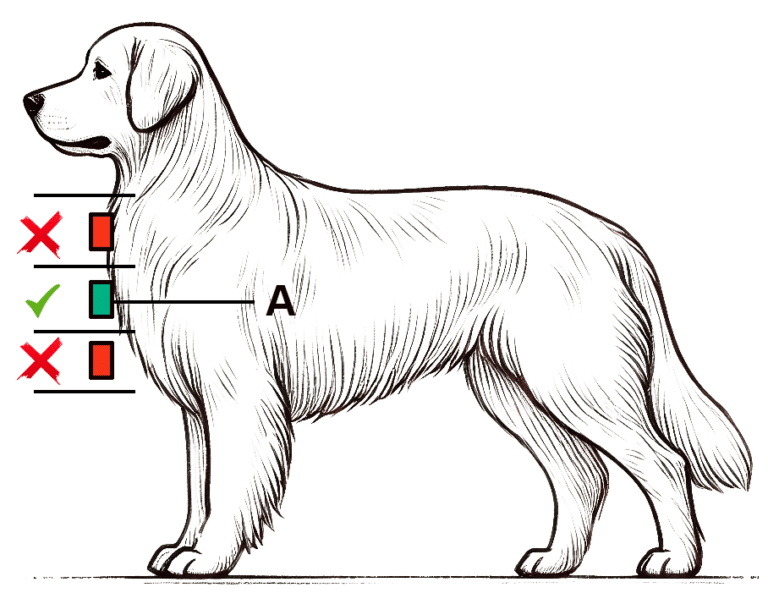
The Different Operating Modes of Echo?
Echo-BlindDog offers three operating modes: Pause Mode (1), Indoor Mode (2), and Outdoor or Active Mode (3).
The blue indicator light on the front of Echo shows the current mode.

The user can switch between modes by pressing the mode selection button.
Upon receipt, Echo-BlindDog is in pause mode (Mode 1):
– No sound emission.
– No indicator light signal is emitted.
By pressing the mode selection button once, you switch to Mode 2:
– One (1) flash of the indicator light signals the selection of “Mode 2.”
– Then, the indicator light emits slow, regular flashes to indicate proper functioning.
– The device starts emitting sound signals in “indoor mode.”
By pressing the mode selection button again, you switch to Mode 3:
– Two (2) flashes of the indicator light signal the selection of “Mode 3.”
– The indicator light then emits fast, regular flashes.
– The device then emits sound signals in “outdoor or active mode.”
For your companion’s comfort, be sure to manually switch back to Mode 2 when returning indoors.
If you forget, the active mode (Mode 3) will automatically deactivate after 40 minutes and switch back to Mode 2.
By pressing the mode selection button once more, you return to Mode 1:
– Three (3) flashes of the indicator light indicate the selection of “Mode 1.”
– No indicator light signal is emitted.
– No sound emission is detected.
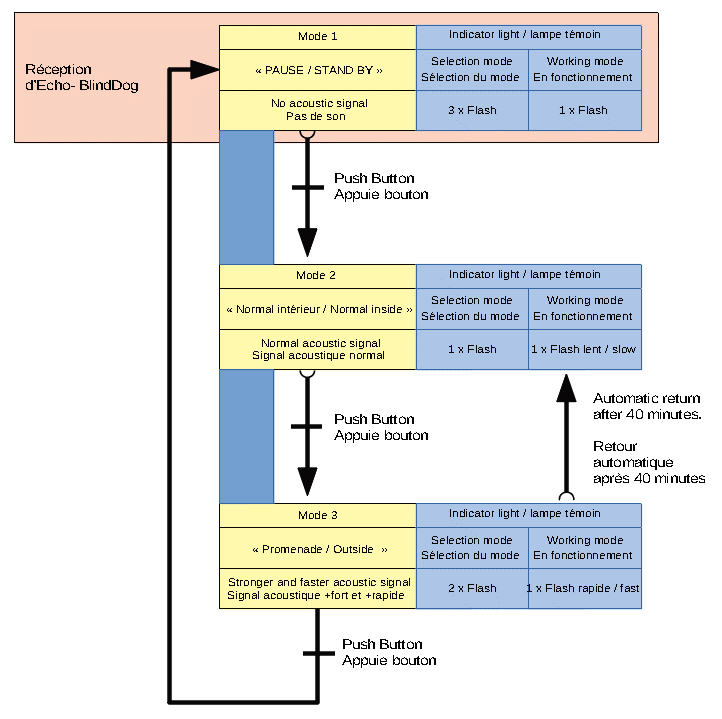
Indicator Light Sequences
The indicator light signals for proper functioning are described in the chapter “The Different Operating Modes of Echo” as well as in the table below. Any other indicator light sequence indicates a malfunction of the device. Although the device is protected by three layers of security to never exceed a certain sound level, if you notice a sequence different from those mentioned in Chapter 3, please immediately remove the device from your dog and refer to Chapter 5.6 (Device Reset). Do not re-equip your dog with the device until the light sequence has returned to normal and you have performed the “reference phone” test.
| Lampe témoin | |||
| Couleur | Pression bouton | Flash en continu | État du système |
| Bleu | 3 x flashs | Sans | OK – Mode pause |
| Bleu | 1 x flash | Régulier/Lent (env. 3,30 sec) | OK – Mode intérieur |
| Bleu | 2 x flash | Régulier/Rapide (env.1,10 sec) | Ok – Mode extérieur |
| Bleu | Quelconque | Très rapide / tous autres | NOT OK |
| Procéder à un RAZ Procéder à un test de téléphone de référence. |
Understanding My Dog Equipped with Echo-BlindDog!
This section is essential for you to anticipate and adapt to your dog’s reactions and detections.
The principle of Echo-BlindDog is echolocation. Its operation is based on the propagation and reflection of sound. Sound is a mechanical wave that propagates through all physical mediums (gas, liquid, solid). The speed of sound propagation depends on the nature of the medium as well as the temperature.
Sound wave propagation in the atmosphere is a complex phenomenon that can be affected by various factors, such as terrain topography, soil nature, and atmospheric characteristics.
1 – The Reflection Phenomenon
Sound waves are reflected by the various obstacles they encounter, including the ground, which can sometimes transmit a sound wave over long distances. When interacting with an obstacle, part of the wave is reflected after being modified by the characteristics of its surface. Reflection can be total on a perfectly smooth reflective surface (e.g., smooth concrete) or partial on an absorbent and/or rough surface. The reflected part can interact with the non-reflected part (direct wave), leading to interference phenomena.
This is why your blind dog will better detect obstacles in urban environments and will detect trees (hard surfaces) better than bushes (soft surfaces). This is also why your dog will not be able to detect negative surfaces like holes.
2 – The Diffraction Phenomenon
When a sound wave encounters a boundary with a discontinuity (edge of an obstacle, hole, etc.), it is affected by diffraction. This phenomenon results in the re-emission of the incident wave in many directions from the discontinuity. It is very common in outdoor acoustics and occurs, for example, in the presence of the top or edges of a wall, an acoustic screen, building edges (walls, roof), or pronounced terrain irregularities (hilltop, mound).
This is why your dog will be able to detect curbs or stairs accurately (hard surfaces + diffraction).
3. Atmospheric Effects
The chemical composition of the air and its physical properties can influence a sound wave during its propagation. These effects are traditionally distinguished into those due to atmospheric absorption and those due to the meteorological characteristics of the atmosphere.
a – Atmospheric Absorption:
Atmospheric absorption is a phenomenon that depends on temperature (the warmer it is, the less absorption there is) and the air’s humidity level (the higher the humidity, the less absorption). It affects high acoustic frequencies more and generally has a significant effect only over long propagation distances.
b – Weather Conditions:
Noise propagation also depends on weather conditions, with sound rays curving up or down depending on the wind direction and temperature gradient. With tailwinds, it is possible to hear highway traffic several hundred meters away and hear it much less with headwinds. During temperature inversions, sound rays curve downward, increasing the perceived noise. For example, after nocturnal cooling, it is possible to hear a train 5 km away from a railway track downwind despite obstacles. Sound is then forced to propagate under the inversion by the waveguide effect.
This is why your dog will use Echo-BlindDog more effectively on dry, warm, windless days. In contrast, rainy days, snow, and wind (such as fans) affect the purity of the Echo-BlindDog’s sound signal.
Learning
The learning process for your dog with Echo-BlindDog occurs progressively in three distinct stages, each accompanied by recommended durations to ensure optimal understanding and build your canine companion’s confidence.
Step 1: Discovery (5 hours to several weeks) Begin in a familiar and simple environment. Activate the system and gently guide the dog while allowing it to get used to the sound signals emitted by Echo-BlindDog. Reward each success positively and ensure the dog associates the sounds with the correct actions.
Step 2: Progression (1 to 3 months) Once the dog has acquired a basic understanding of the system, move on to more complex environments. Gradually introduce additional obstacles, encouraging the dog to actively use Echo-BlindDog to navigate. Continue to provide rewards and positive encouragement to reinforce the desired behavior.
Step 3: Assimilation (beyond 3 months) To fully strengthen the dog’s skills, simulate real-life situations. Take familiar routes with your dog, using Echo-BlindDog to detect and avoid obstacles. Repeat these scenarios to build the dog’s confidence and competence in various environments. Keep providing positive reinforcement and adjust the difficulty level based on your companion’s progress.
These recommended durations serve as guidelines, but it is essential to adapt to your dog’s individual pace, paying close attention to its safety, reactions, and comfort throughout the learning process.
Warning: Risk of Falls! Echo-BlindDog does not detect negative surfaces and objects such as holes.
I can't hear the sound from my dog's device?
Echo emits sounds outside the range of human hearing, so you won’t be able to hear it!
To test if the device is functioning correctly, you should:
Check the presence of the regular blue visual indicator, which tells you that the program is running correctly!
Verify that the sound emitters are working by using the “reference mobile phone” method.
Note: Any other sequences of the blue visual indicator signal a malfunction. In this case, immediately remove Echo-BlindDog from your dog. Proceed as described in the “Device Reset” and “Reference Phone” sections. If you are unable to restore a normal light sequence, please contact us through the contact form and describe the blue light sequence.
Verification of Sound Emissions and the 'Reference Phone' Method
Although the sound emissions of Echo-BlindDog are outside the range of human hearing, you can verify its proper functioning by following these steps:
– Ensure the regular blue visual indicator is present, showing that the program is operating correctly.
– Get your mobile phone and open your sound recording application.
– Place the microphone of your phone about 1 cm – 5 cm away from the piezoelectric emitter of Echo that you want to test.
– Record for about 30 seconds.
– Play back the recording.
– When playing the recording on your mobile phone:
If you hear the clicking sounds, this confirms that the device is working correctly and emitting the sound signals. You can use this mobile phone as your “reference phone” for all future checks of the device’s functioning.
If you do not hear the clicking sounds, your phone’s microphone may not be able to capture the frequency emitted by Echo-BlindDog. Repeat the process with a different phone model until you find a “reference phone” capable of recording the sound frequency of Echo-BlindDog.
Note: We recommend defining a reference phone as soon as you receive Echo-BlindDog. This will allow you to ensure the complete functionality of your dog’s device during future verifications.
Resetting the Device (Hard Reboot of Echo-BlindDog)
In case of a malfunction or abnormal indicator light sequence, follow these steps to reset the Echo-BlindDog device:
For Echo Version 2: Gently remove the cover of the reset button located at the back of the device.
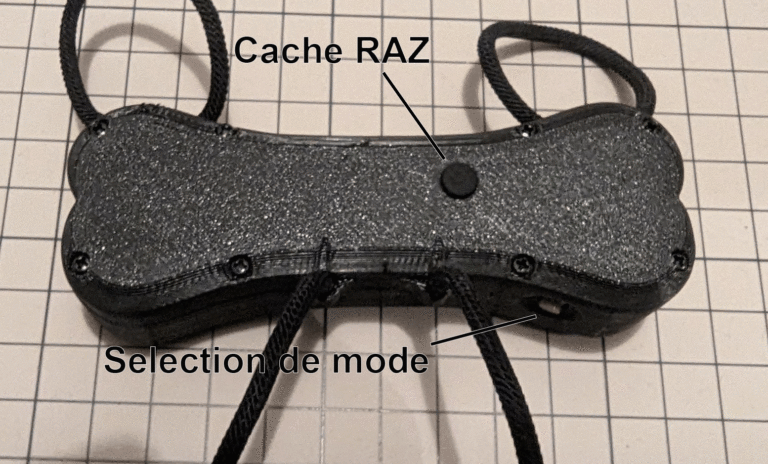
Using a toothpick, press and hold the reset button (RAZ) along with the mode selection button for 10 seconds.
Release the buttons and observe the indicator light sequence.
- If the indicator light sequence returns to normal, the device has been successfully reset.
- If the indicator light sequence remains abnormal, please repeat the reset procedure.
- Before re-equipping the dog with the device, ensure that the indicator light sequence has returned to normal and perform the “reference phone” test described in chapter 2.6 to confirm the device’s proper functioning.
For Echo Version 3: Press and hold the reset button (RAZ) along with the mode selection button for 10 seconds.
Release the buttons and observe the indicator light sequence.
- If the indicator light sequence returns to normal, the device has been successfully reset.
- If the indicator light sequence remains abnormal, please repeat the reset procedure.
- Before re-equipping the dog with the device, ensure that the indicator light sequence has returned to normal and perform the “reference phone” test described in chapter 2.6 to confirm the device’s proper functioning.
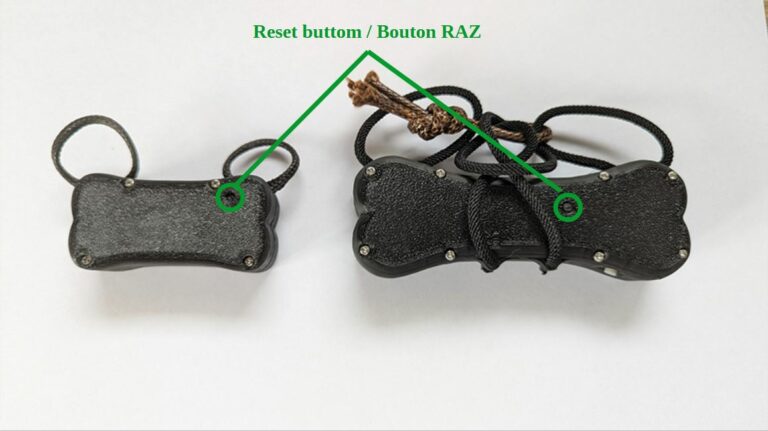
Battery Life and Recharging
The battery life of Echo is estimated at 90 to 120 days for the Echo-Large model and over 40 to 60 days for the Echo-Small model.
Echo is recharged using a USB Type-C port and a phone charger.
Note 1: It is not recommended to use fast chargers.
Note 2: We strongly recommend recharging the battery for one hour every month to preserve its capacity and optimize its lifespan.
Maintenance and Cleaning
Piezoelectric Emitters
The piezoelectric emitters are essential components of the Echo System. Regular maintenance is necessary to ensure their proper functioning and prolong their lifespan.
Regular Cleaning
Avoid dirt accumulation: The emitters can collect dust, dirt, or other particles. Use a dry brush and a soft, dry cloth to gently clean the external surfaces of the emitters.
Do not use solvents or other products: Avoid using harsh chemical solvents, alcohol, or other substances that could damage the surfaces of the emitters.
Visual Inspection
Check the physical condition: Regularly perform a visual inspection of the emitters to detect any signs of damage, cracks, or excessive wear.
Protection Against Moisture
Avoid prolonged exposure to moisture: Although the system is weather-resistant, avoid extended exposure to excessively humid environments, as this could affect the performance of the emitters.
Use and Drying in Rain or Wet Tall Grass
If your dog’s behavior changes during a walk: If the emitters are wet, their sound emissions may be significantly altered. Strongly blow on the emitters to remove excess water/moisture so that your dog regains its auditory assistance. Repeat the process as many times as necessary.
Thoroughly dry after use in the rain: If the system is used in the rain, make sure to thoroughly dry the emitters/receivers after each use to prevent any moisture-related damage.
Periodic Testing
Perform functional tests: Periodically conduct functional tests (“reference phone”) of the system in controlled conditions to ensure that the emitters/receivers are working correctly.
By following these maintenance recommendations, you will ensure optimal operation of the piezoelectric emitters/receivers, contributing to the overall performance of the Echolocation System for Blind Dogs.
Water and Humidity
Water:
Echo is technically not waterproof. It is strongly advised not to submerge the device, as this could damage the internal electronic components and compromise the system’s proper functioning.
Humidity:
Although the system is resistant to normal weather conditions, prolonged exposure of the piezoelectric transducers to moisture can temporarily affect the sound performance of the device.
Note: If your dog’s behavior changes during a walk, check if the emitters are wet, as their sound emissions can be significantly altered. Strongly blow on the emitters to remove excess water/moisture so that your dog regains its auditory assistance. Repeat the process as many times as necessary.
Thoroughly dry after use in the rain: If the system is used in the rain, make sure to thoroughly dry the emitters after each use to prevent any moisture-related damage.
Warranty
The Echo-BlindDog device is covered by a one-year warranty from the date of purchase, ensuring its quality and reliability. The warranty covers manufacturing defects and issues related to normal use of the device.
However, the warranty does not apply in cases of abnormal use of the device, including the following situations:
Unauthorized Alterations: Any unauthorized modification of the device will void the warranty.
Physical Damage: Damage caused by rough handling, shocks, lack of maintenance, or exposure to extreme environmental conditions or immersion is not covered.
Improper Use: Use contrary to the instructions provided in the manual voids the warranty.
Unauthorized Repairs: Attempts to repair the device by unauthorized persons will void the warranty.
For any warranty claims, please contact us via the website www.echo-blinddog.com.
